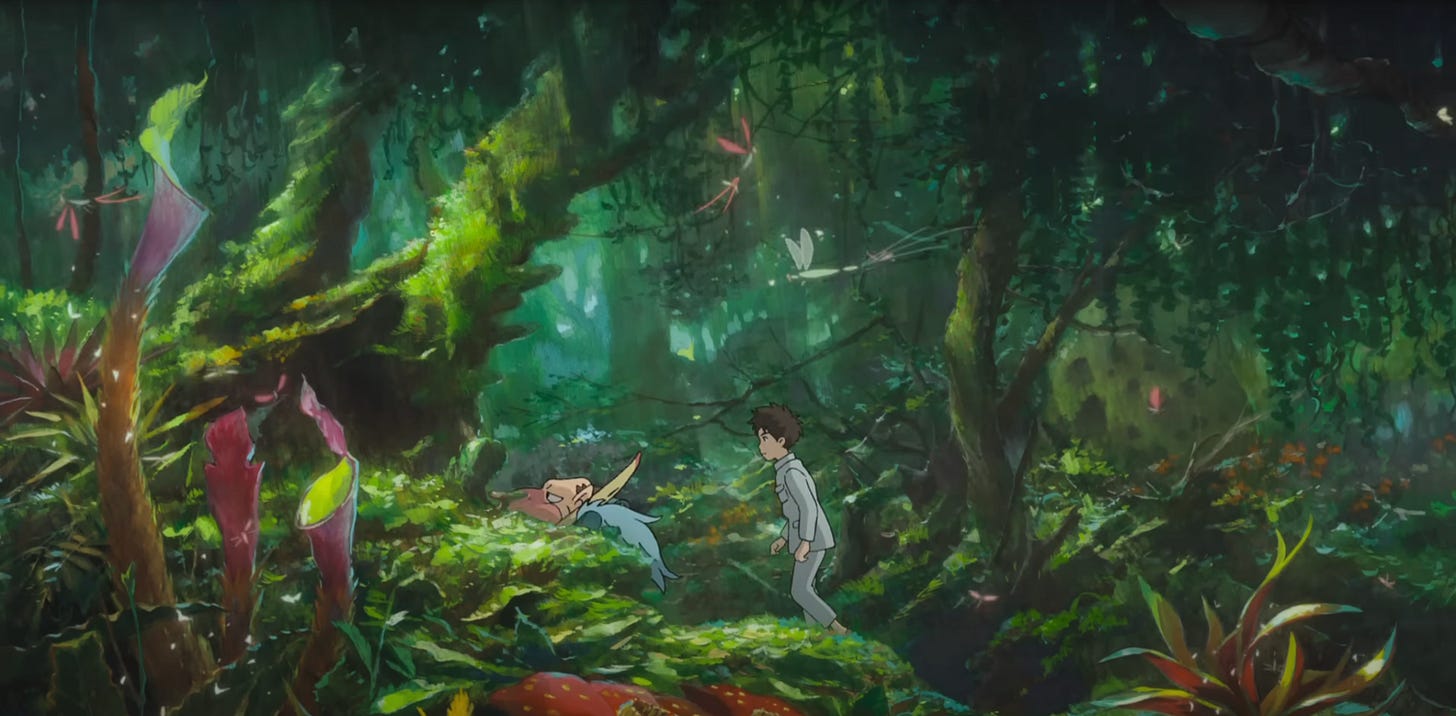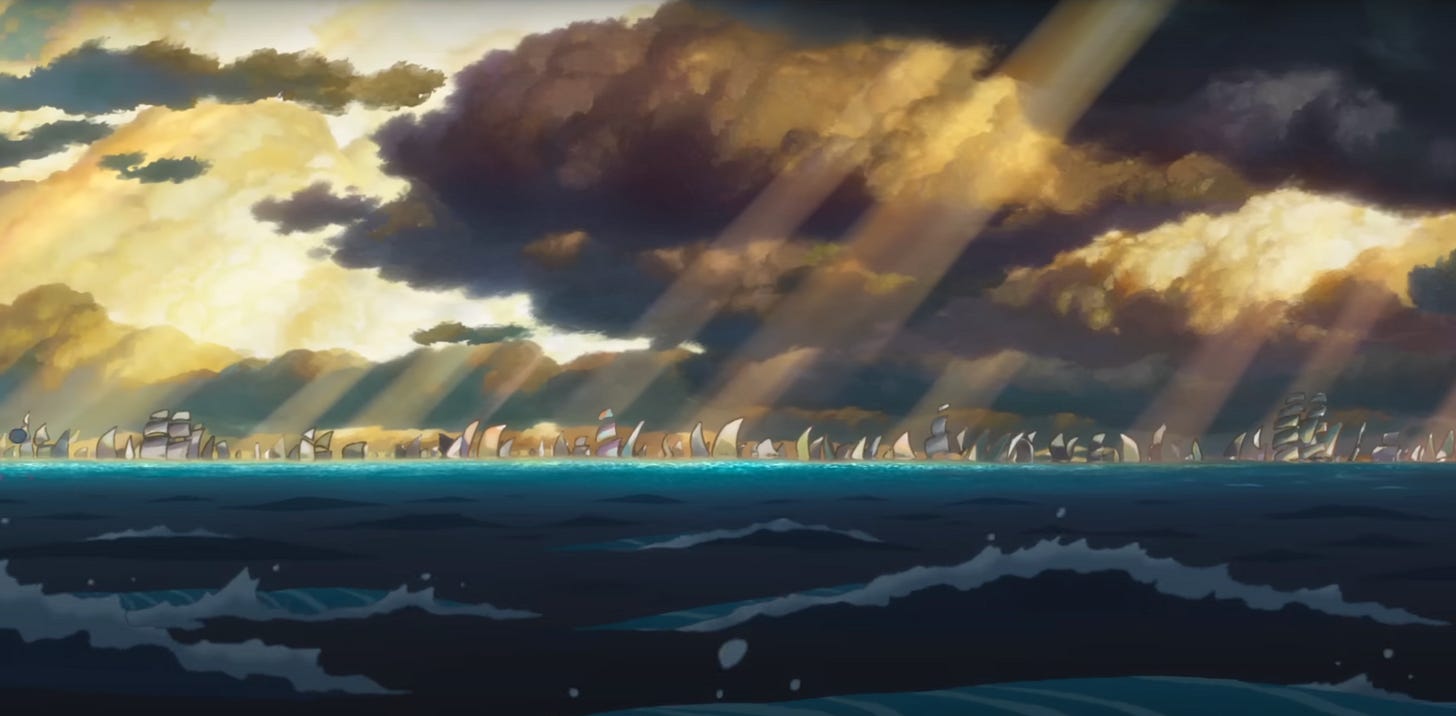How do you live?
We live, die, and see some fucking great movies along the way thanks to Miyazaki
I normally shy away from writing about media — I’m not exactly the most awake to culture and it takes a lot to draw me out from under my woolly blanket of ignorance (fully occupied by my fragile headspace, non-stop existential howling, and the occasional lofi hiphop beats). So I consider myself pretty unqualified to have opinions on movies, music, etc. and also worry poor attempts to translate art into language end up diminishing rather than expounding the original creation.
That said, I’m attempting to write this anyway, partly because I have more free time than I know what to do with now that I’m settled into funemployment1 and because The Boy and the Heron is the best thing I’ve seen in a very long time.
It was the first movie I saw in theaters alone, twice — I walked in carrying a full bag of popcorn and half a cup of self-consciousness after failed last minute attempts to drag friends along, and walked out convinced that certain films aren’t meant to be blunted by companionship. Stories can erode in the space and hidden crevices that form between people, whereas good stories pierce straight through the soul when we allow ourselves to see and fully be seen.
- Spoilers ahead -
Miyazaki’s work is more often than not stunningly deceptive. For someone supposedly in the business of children’s entertainment he has a lot of loaded stuff to say: about the environment, human nature, peace and brutality and how they run concurrently through all living things. “Animator” and “filmmaker” represent but a sliver of his contributions to society; at core he’s an artist compelled to illuminate our place in the world, and his work presents real Thought — ever endangered these days as we drown in content fighting to say anything without knowing what it means to say.
Throwing oneself into a Miyazaki film is therefore a gradual descent into madness or enlightenment, it’s hard to tell, as enlightenment dresses as madness in the Ghibli world and madness plays a cast of whimsical characters, most of whom have a quiet point of view on morality.
The Boy and the Heron bears its director’s signature stamp of deception in multiple places: its unassuming English title; the disproportionate depth, visually and philosophically, captured in a 2D world; its use of children’s animation as a light-hearted facade for an anguished swan song on life and one’s legacy. At the heart of the feature lies the question How Do You Live? which is its Japanese film title borrowed from Miyazaki’s favorite childhood book. Rather than being handed a direct answer, we’re guided on a journey (by a lying blue heron, excellently voiced by Robert Pattinson) traversing a twilight realm — somewhere between the dead and living worlds — that carries all the component pieces.
The movie follows 11-year old Mahito through his traumatizing WWII-era reality, upended with his mother’s death in the Tokyo firebombing, his father’s seemingly effortless remarriage to his aunt, and a new life with a kind exterior that glosses over the need for grief. Through the haze of getting settled into these changes, Mahito stumbles upon a mysterious tower on his ancestral grounds. The tower houses a magical oceanic world where the living and dead coexist. Among the predatory bird populations, “warawara” to be born as souls up above, and younger dupes of Mahito’s relatives passing through this world in a non-linear time waltz, we lose track of who is here, who has left, and whether life and death are discrete or two sides of the same communal fabric. The sea world turns time into origami, bending the present and bygone, folding impermanence into something ethereal and lasting to guide us forward — through loss, despair, and resilience.
It’s simultaneously Miyazaki’s most fantastical and explicit movie yet. When Mahito finally meets Grand Uncle, the tower master and creator, he chooses Mahito as his successor, entreating him to carry on his legacy and forge a world that transcends the chaos and suffering outside, one “untainted with malice.” The legendary director’s voice carries directly through Grand Uncle’s in a denouement that breaks the fourth wall:
There is more work to be done… Whether this world becomes a thing of beauty or an abomination is entirely in your hands.
Miyazaki’s magnum opus grapples with meta endings — of his own failure to find a Studio Ghibli heir, life and the love we give, memory and inheritance, institutions and the worlds we construct. At the end of the day life is loss compounded. Everything we build, whether temporarily, by happenstance, or by decades of dedication to a cause comes to an end, and the question of how to live becomes one of how to live with the weight of the knowledge that there is inevitable demise around the corner.
Mahito ends up declining Grand Uncle’s request, seeing the malice inside himself and choosing instead to return home to an imperfect world — one where life after loss hinges on memories dissolving with time and where we gravitate towards forgetting, individually and collectively.
It’s a film about endings, but the irony is Miyazaki must know art may be the only immortal thing there is. Even without a successor and in the absence of further Ghibli productions, he has created something close to the scale of existence itself that need not survive through this generation’s remembrance to touch future generations.
Like all art, The Boy and the Heron is opinionated, open to interpretation, and lives beyond its medium. I can’t claim to have understood it completely, though I will say it left me with a deep longing and comparative awareness of what is amiss with modern content. The “art versus content” debate is not a new one — we live in a culture defined by content’s omnipresence while art becomes increasingly niche, and we’re quickly losing the ability to tell the difference. So much contemporary media trivializes human experience for maximum relatability and cheapens entertainment for profit — it is no longer cool, nor does it pay, to speak in nuance or read into subtext. The internet is awash in clickbait thinking and memeification, and I long for more art like Miyazaki’s that is unabashedly real, patient and purposeful, and made with soulful urgency, refracting the world around us and asking, earnestly, where we’re headed.
The Boy and the Heron’s theme track comes closer to capturing the film’s essence where my words have only been marginally successful.
Hit me up for cafe dates if you are reading this since that means you’re a real one, and subscribe to be the realest 💌








